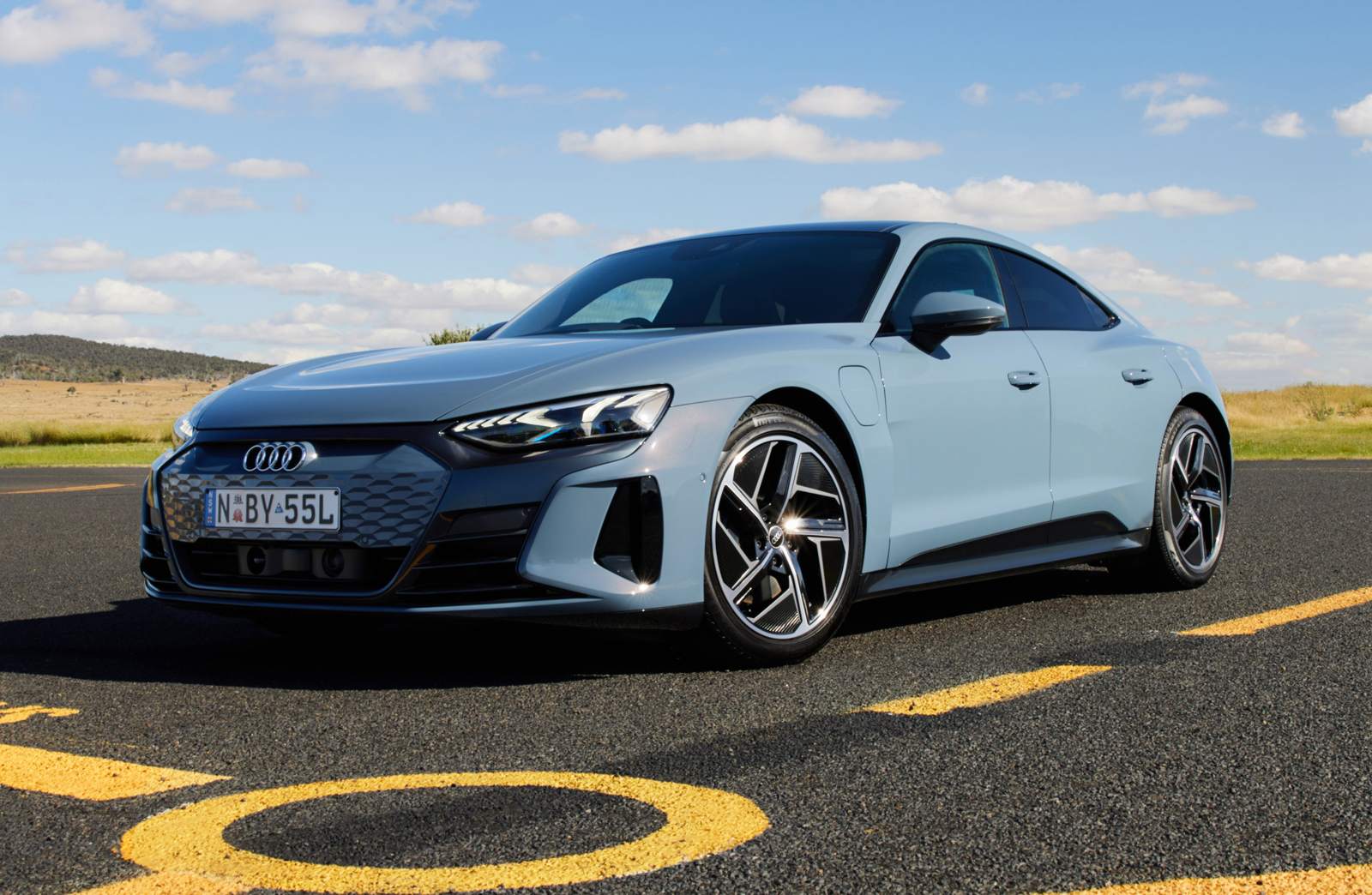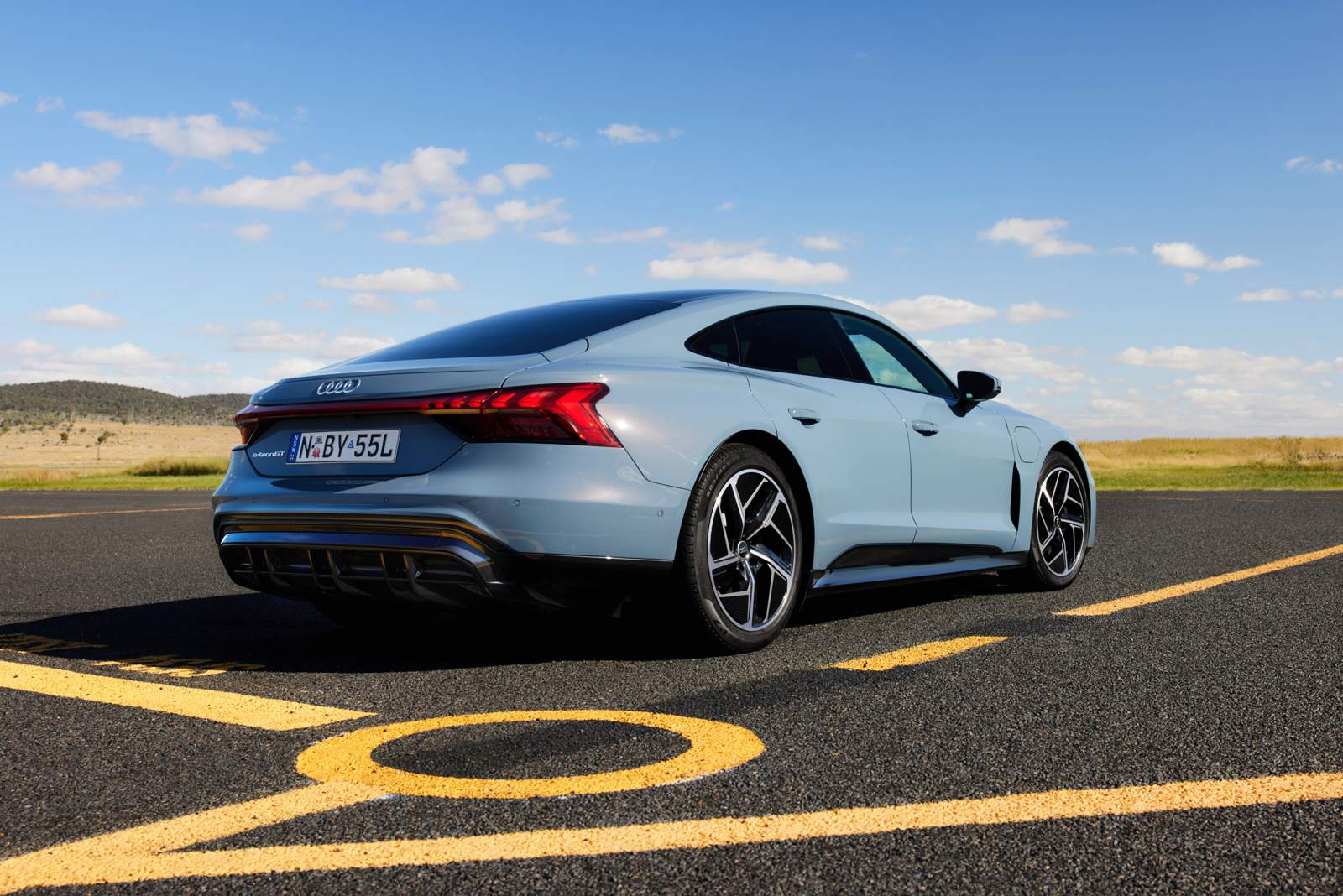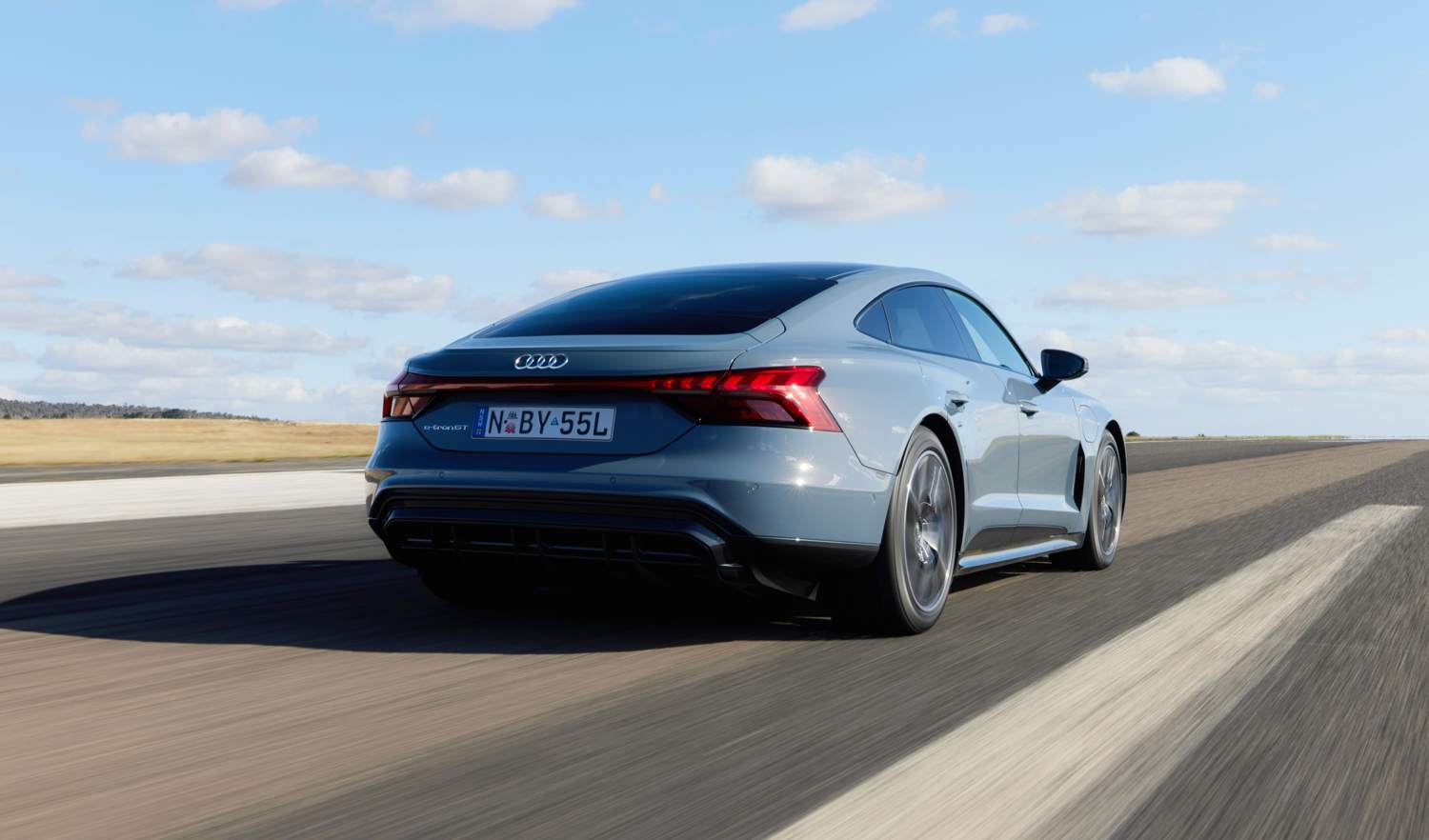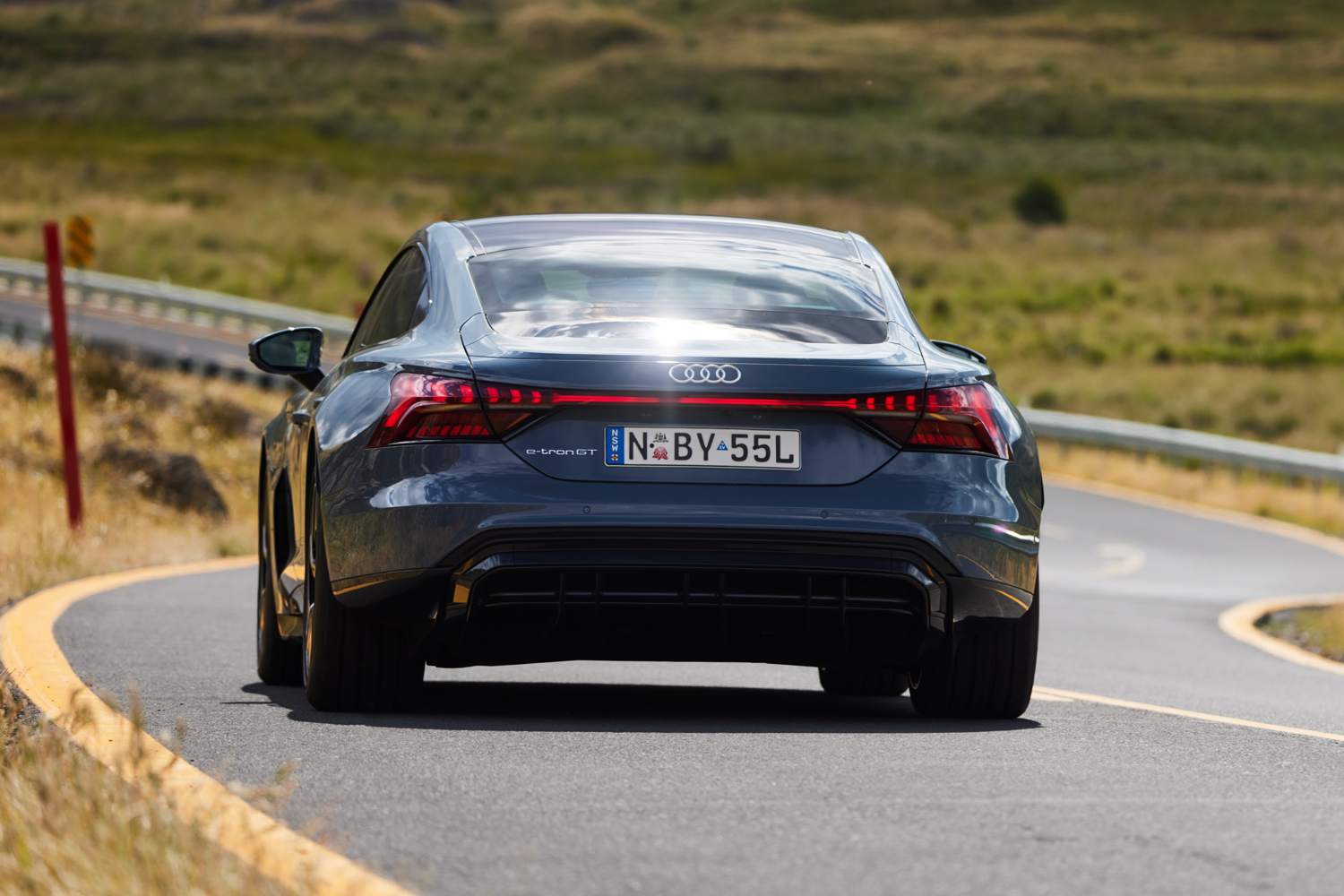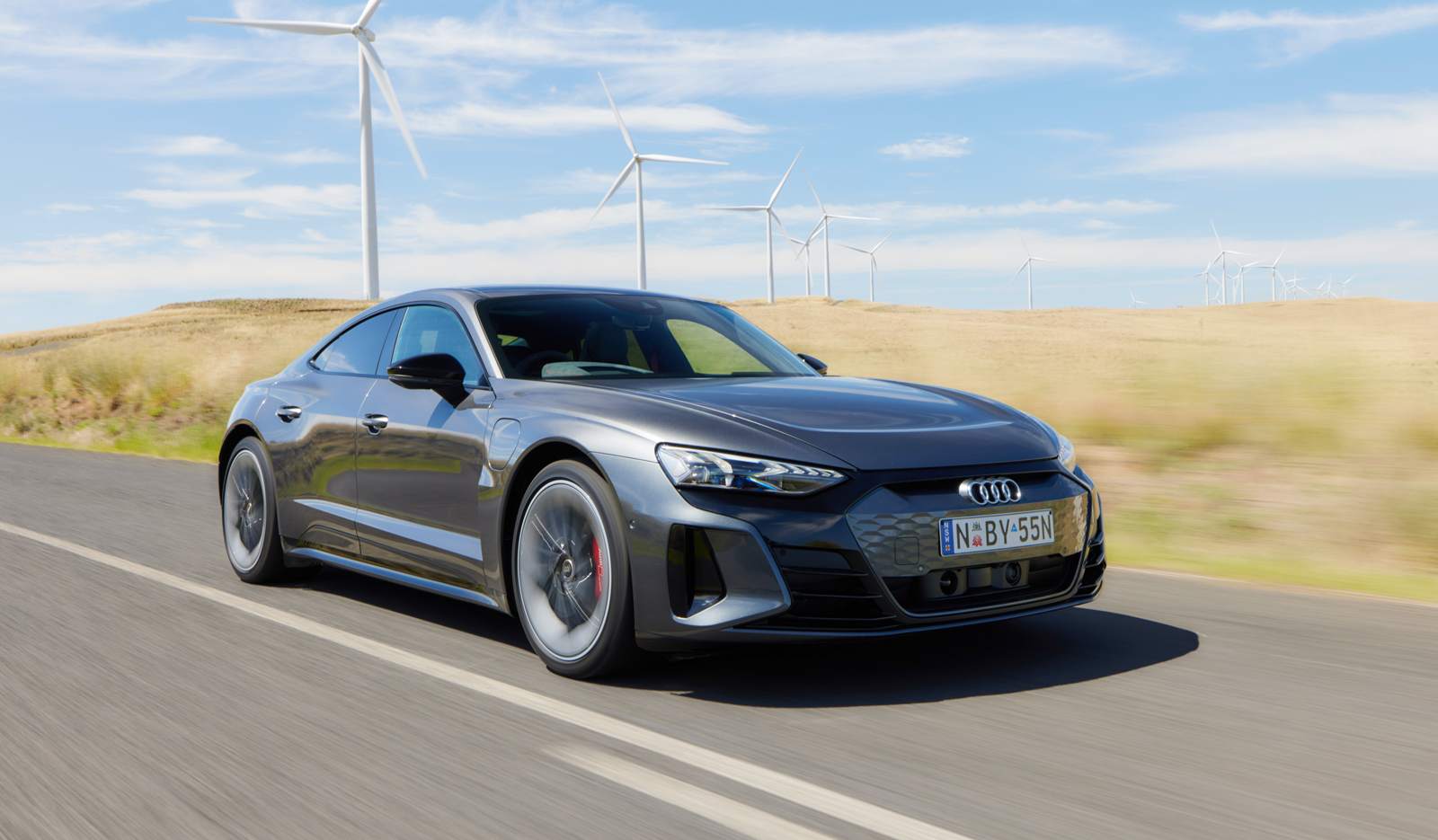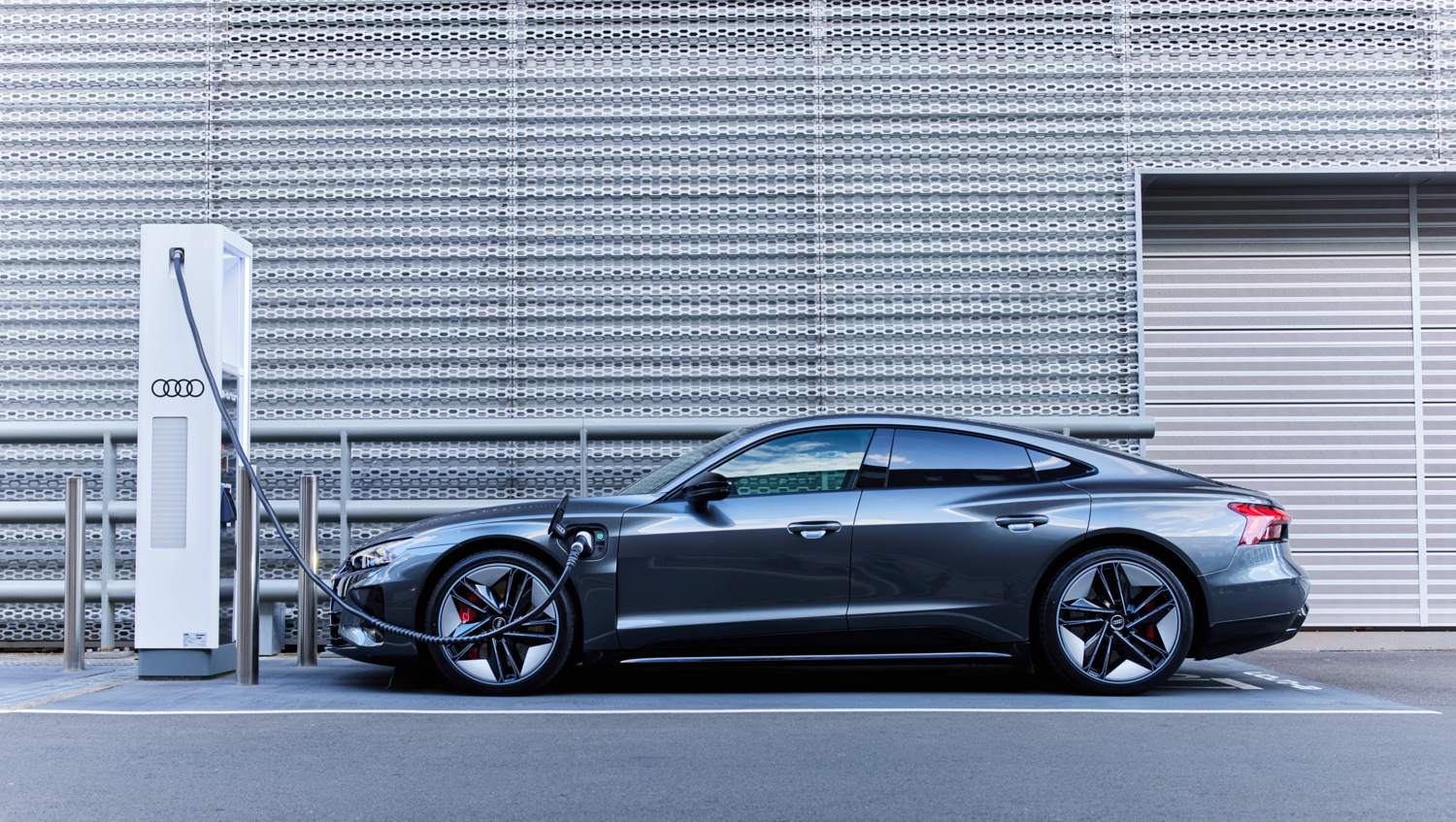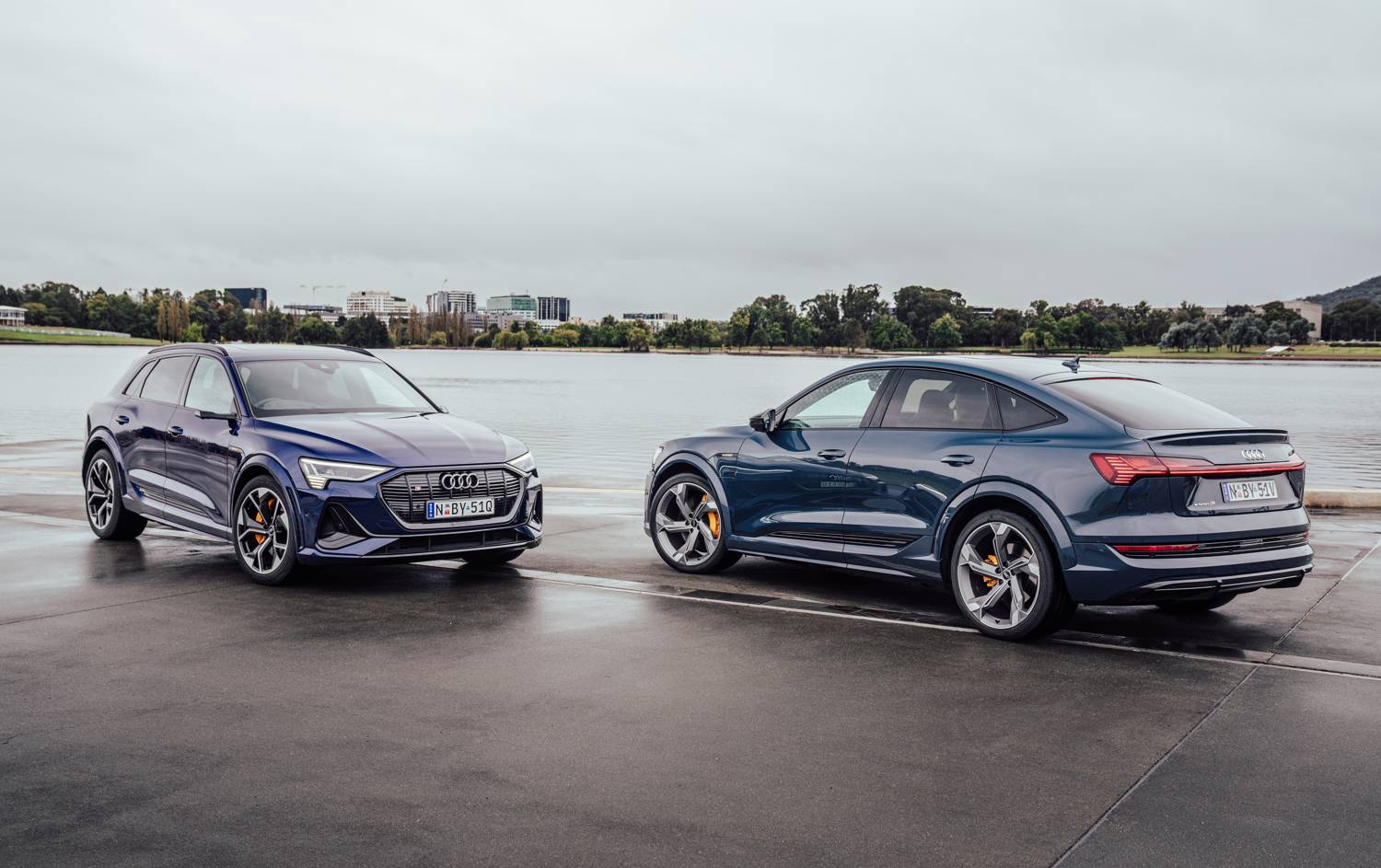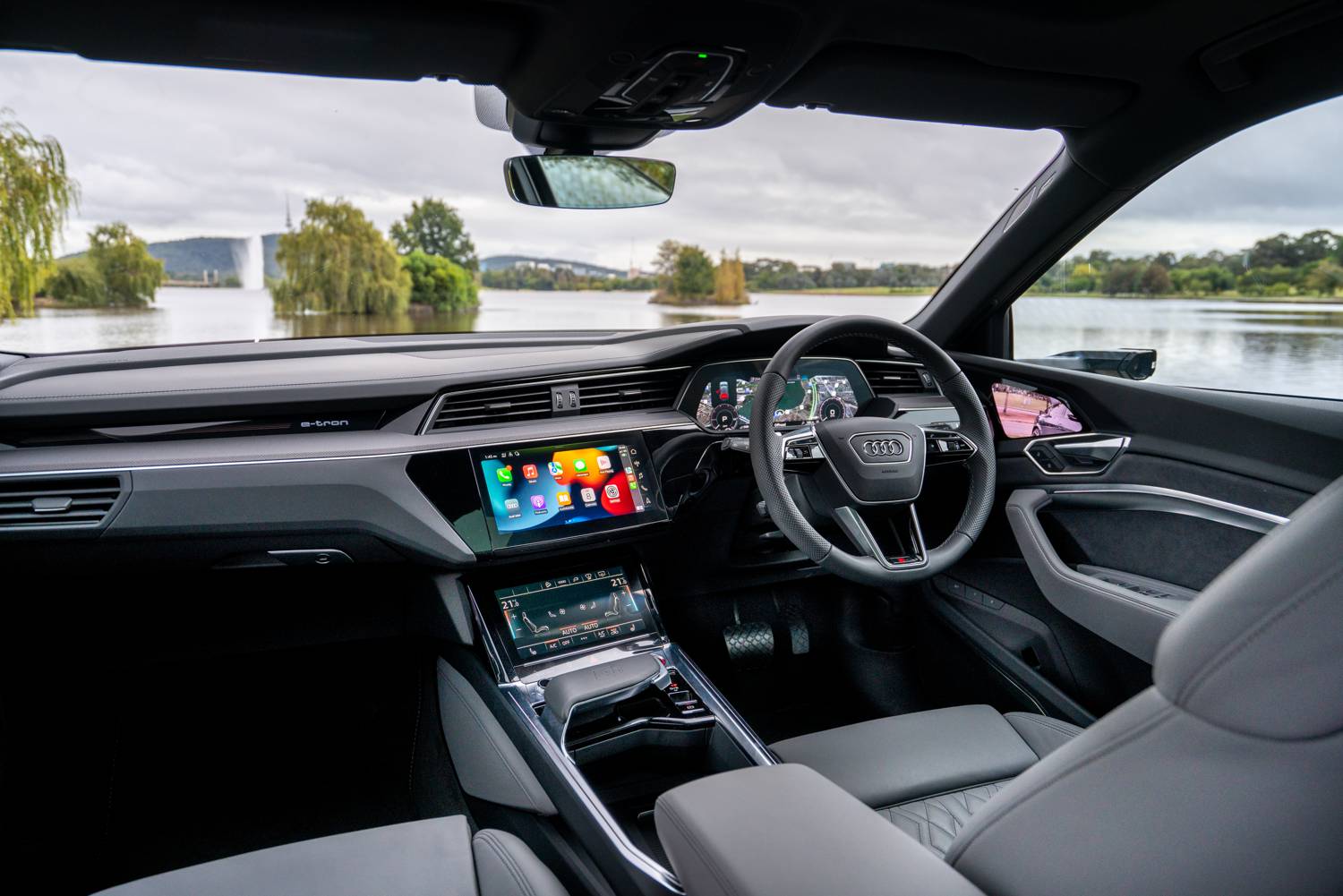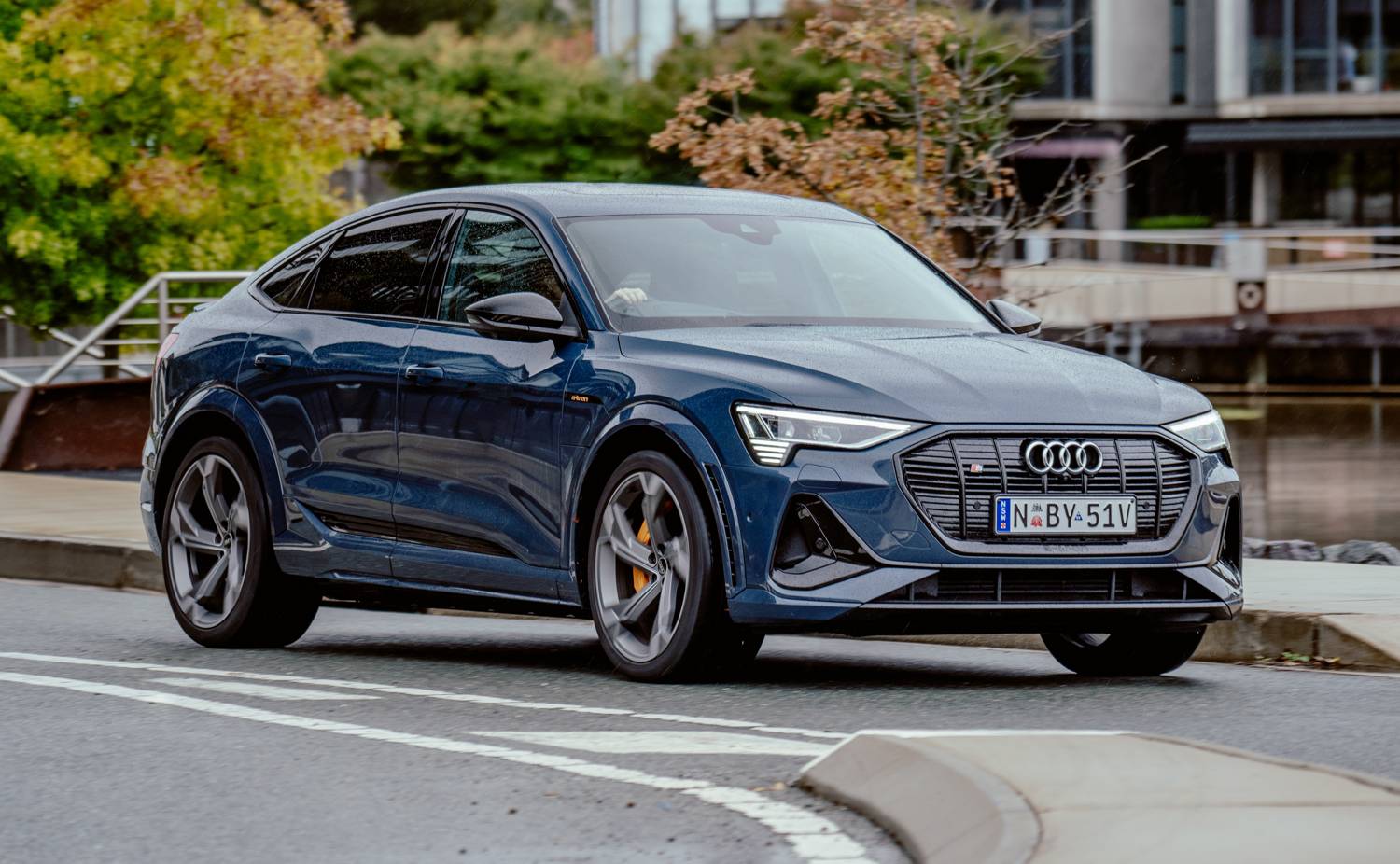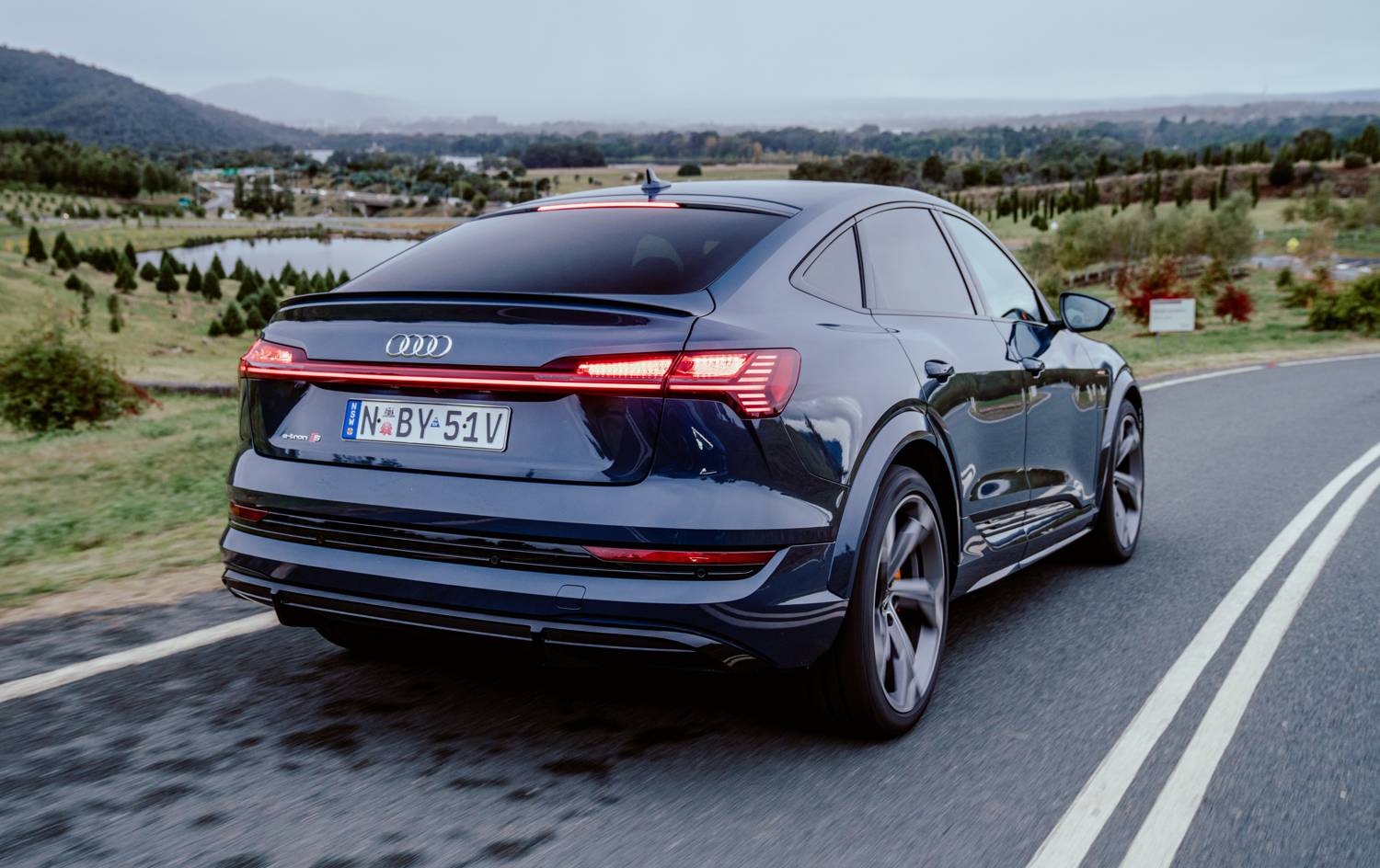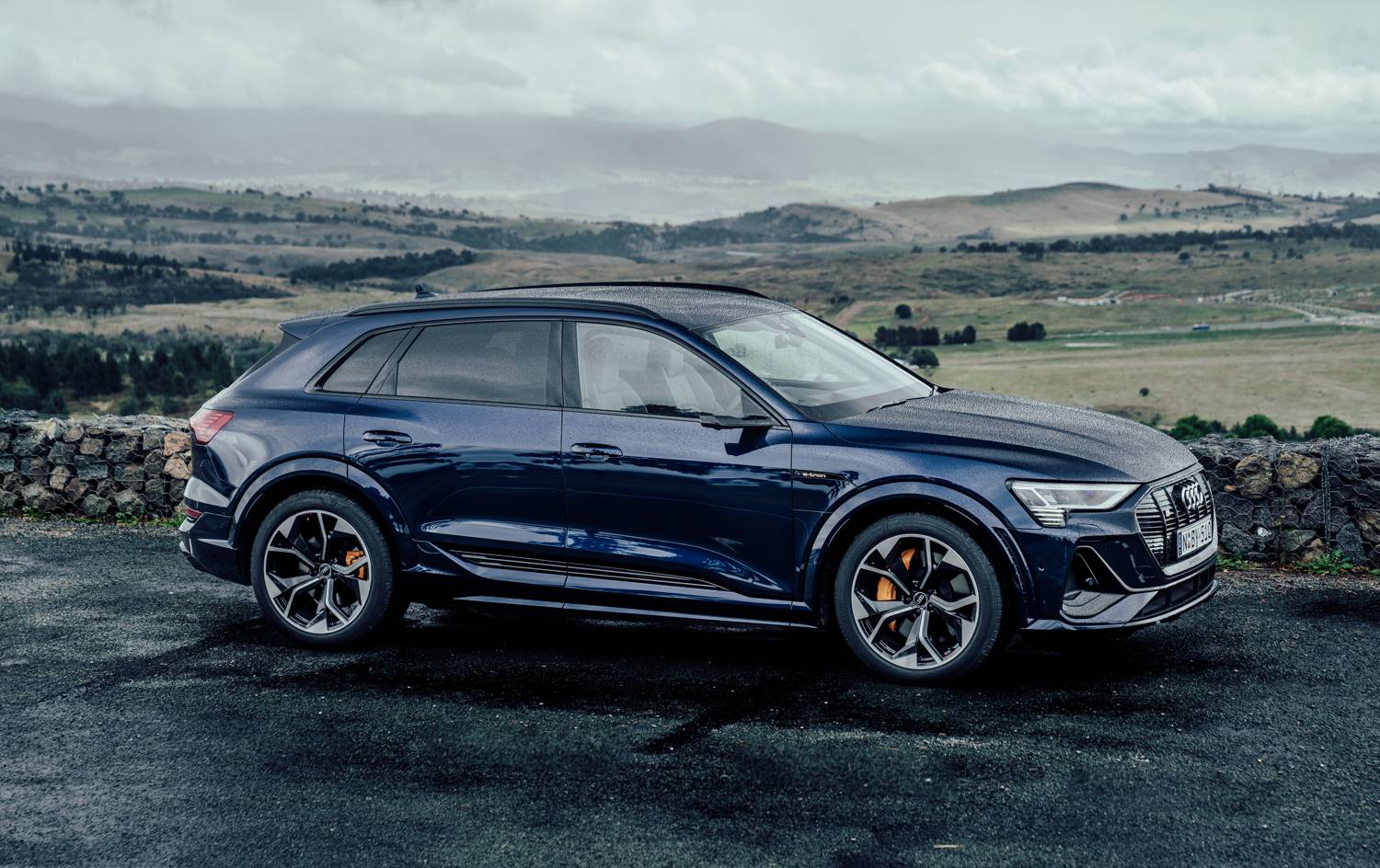With Audi’s e-tron range set for further expansion later this year with the Q8 e-tron, we tap into Ingolstadt’s current electric line-up.
Power Bank
Audi has an enviable history of bringing together technologyand design in a desirable package. The e-tron GT is yet another entry into that impressive catalogue of work.
T HE MOST BEAUTIFUL CAR I have ever drawn,” exclaimed Marc Lichte, Head of Audi Design, when the Audi e-tron GT Concept was shown in Los Angeles in 2018. This is bold claim for a designer who has overseen generations of attractive models from the brand, but Lichte’s passion for the project is evident any time the topic is raised. In fact, it takes just the smallest nudge to steer Lichte to the design of the e-tron GT.
The e-tron GT and RS e-tron GT share the same J1 platform used by the Porsche Taycan models, but Audi’s design and engineering teams have successfully given their models a distinct look and feel. In fact, in our experience, it takes industry background knowledge to draw similarities between the two gran turismo EV ranges. And to our eyes, Lichte’s design work on the e-tron GT is more successful and cohesive than that of the Taycan.
“You cannot create a design icon on the drawing board. A car must acquire this reputation on the road,” says Lichte with genuine modesty. “True design icons have something that is unmistakably clear: For example, it takes only three lines to characterise a VW Beetle or a Porsche 911. They stand for a clear attitude.”
The e-tron GT opens the batting for the two- model range, sitting below the RS-badged flagship model. As with the proliferation of Taycan models, we suspect that additional variants will filter into the e-tron range, perhaps both below the e-tron GT and above even the RS. For now, however, we’re sat behind the wheel of an e-tron GT and excited to find out whether the new Audi ticks the boxes to satisfy not only the early adopters who often gravitate towards EVs, but also dyed in the wool car enthusiasts such as you and I.
 Unlike so many companies that try to signal the EV-status of their new model by over-designing and ‘futurising’ every aspect of the car, the e-tron GT looks and feels like a ‘normal’ car both inside and out. It’s certainly a striking-looking vehicle, but its design is harmonious – and to our eyes at least, more successful than the Porsche Taycan. The harmonious story continues inside with a well thought-out interior that marries the expected technology with understated luxury. It’s what Audi has been doing for decades, so it shouldn’t come as a surprise, but it’s nice to see that the brand wasn’t tempted to throw out the playbook just because of the change in propulsion.
Unlike so many companies that try to signal the EV-status of their new model by over-designing and ‘futurising’ every aspect of the car, the e-tron GT looks and feels like a ‘normal’ car both inside and out. It’s certainly a striking-looking vehicle, but its design is harmonious – and to our eyes at least, more successful than the Porsche Taycan. The harmonious story continues inside with a well thought-out interior that marries the expected technology with understated luxury. It’s what Audi has been doing for decades, so it shouldn’t come as a surprise, but it’s nice to see that the brand wasn’t tempted to throw out the playbook just because of the change in propulsion.
As with its RS big brother, the Audi e-tron GT quattro is based on the VW Group’s J1 platform, the very same that underpins Porsche’s highly impressive Taycan models. As with the Porsche models and the RS, the GT has a 93kWh battery and uses the same motors on the front and rear axle, with a two-speed gearbox on the rear.
At 350kW it generates less power than the RS, which produces 440kW, but the GT quattro still delivers that instant get up and go so loved by electric car owners and can, according to the NEDC figures, provide a 504km range.
The 93kWh battery is slung between the axles, and 83.7kWh is used to power the car’s two motors: a 175kW motor on the front axle with another on the rear producing 320kW, which transmits its power through a two-speed gearbox. Although the lower of the two ratios is only engaged if you select Dynamic mode or launch control.
The e-tron GT reaches 100km/h in 4.5-seconds, reduced by four-tenths when launch control and the 390kW overboost function are engaged (the latter lasting for 2.5 seconds). Top speed? 245km/h.
The skateboard design of the J1 chassis is suspended by double-wishbones at the front and a multi-link set-up for the rear. Unlike in some overseas markets, Australian-spec e-tron GTs are fitted as standard with air suspension per the RS models. Torque vectoring is standard on the rear axle of the e-tron GT in place of the RS’s more sophisticated e-diff.
The two paddles behind the steering wheel allow you to adjust brake regeneration, although on its maximum setting it doesn’t convert the GT into a one pedal car. Some will consider this a missed opportunity although others will like the coasting capability you’d associate with a GT car when you lift off. Vast 20-inch wheels are standard, with a 245/45 and 285/40 tyre front and rear, respectively.
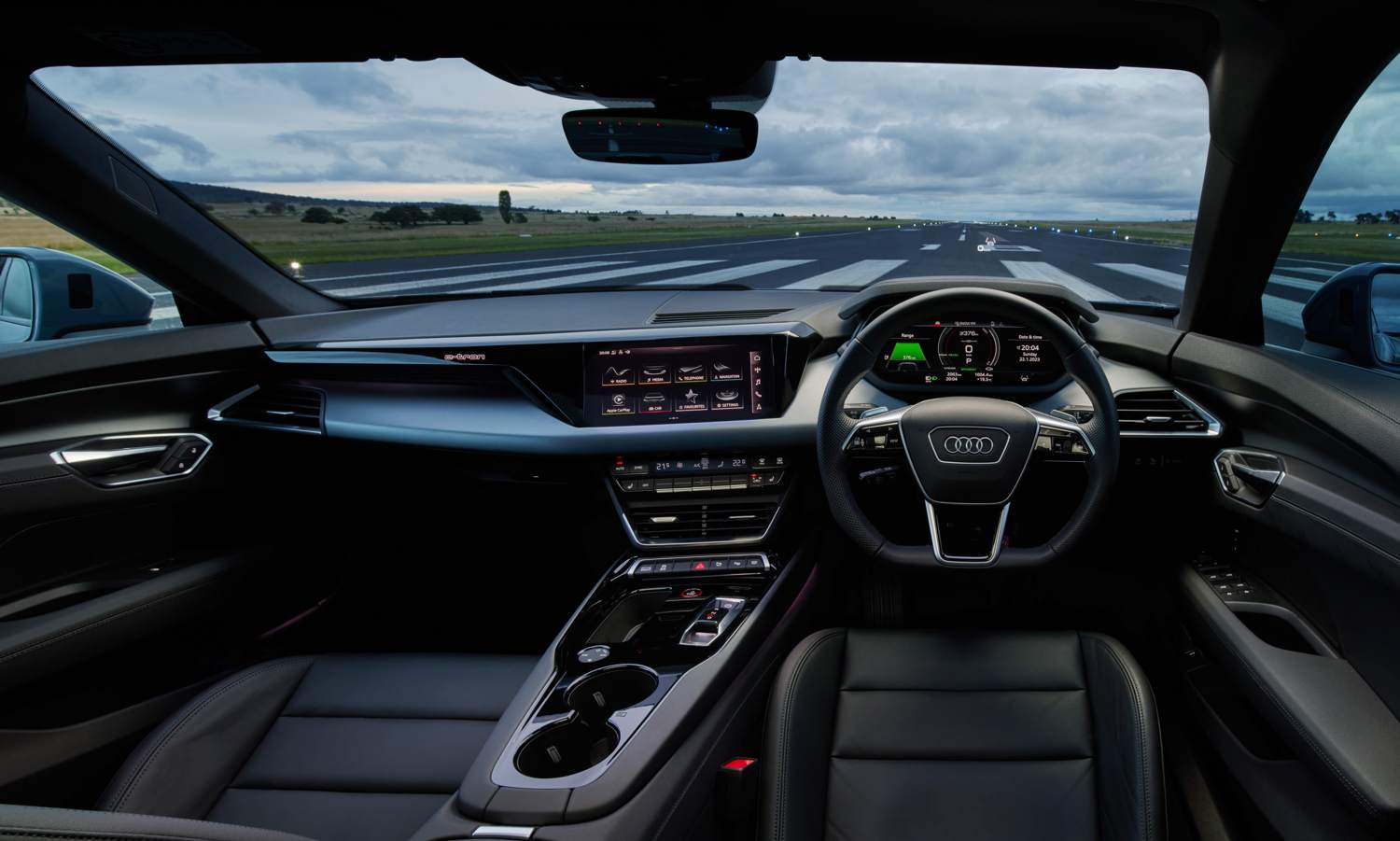 Charging is via ports positioned behind the front wheels on either side of the car, with the offside one being an AC charging port with the nearside capable of taking an AC or DC charge. There’s an 11kW onboard charger and if you can find an 800-volt charging station, it can rapid charge at 270kW or use a 400-volt 150kW rapid charge. Find the former and the battery can be charged from zero to 80 percent in 30 minutes, or you can add 100km of range in just 5 minutes.
Charging is via ports positioned behind the front wheels on either side of the car, with the offside one being an AC charging port with the nearside capable of taking an AC or DC charge. There’s an 11kW onboard charger and if you can find an 800-volt charging station, it can rapid charge at 270kW or use a 400-volt 150kW rapid charge. Find the former and the battery can be charged from zero to 80 percent in 30 minutes, or you can add 100km of range in just 5 minutes.
As with the RS GT and its Porsche Taycan cousins the e-tron GT is a supreme GT car. Smooth, relaxed, eerily quiet and capable of covering kilometres swiftly and with an unexpected level of competence.
It rides with an uncharacteristic calmness, flowing across the surface rather than tap dancing along it as you might expect with such big wheels and low-profile tyres. The steering manages to hook you in and out of a turn without any dramas.
Across our route, the e-tron GT flows from open corner to open corner, maintaining a pace that would require something with a very serious powertrain to work a little harder to pass and leave the GT behind.
Over our test route it proved to be a car operating well within itself. The instant torque – 630Nm, or 640Nm in boost mode – allows for effortless overtaking and a generous shove out of corners and along the straights when required, resulting in a car that brings together the very best elements of the very best GT cars in something that would also give comparable super sedans a fright.
Like all big EV sedans, the e-tron GT quattro is a lovely car to travel in and has a level of performance to keep the journey interesting. It also lays the foundation upon which the RS variant can build to deliver the Thrill of Driving.
The Future of Fast
The RS e-tron GT is the brand’s first EV to wear its most sporting badge and it provides more than a glimpse into Audi’s future of performance cars.
THIRTY YEARS AGO, AUDI’S FERDINAND Piëch turned to his family’s business, Porsche, to build him a car that would redefine Audi just as the Ur Quattro had in 1980. The RS2 was a project only Piëch could sanction and the result was an 80 Avant with so much Porsche knowhow thrown at it that it felt more of a fully fledged Zuffenhausen car than the 924.
Now Audi has taken a new generation of Porsche underpinnings to create a brand-new EV in the same factory where its R8 supercar is built and where it assembled 924s and 944s for Porsche all those decades ago. Taking the J1 platform that underpins the impressive Taycan, Audi also utilises the same electric front and rear motors and their respective single- and two-speed gearboxes that Porsche has put to such good use in its Taycan Turbo and Turbo S models. The resulting Audi is the RS e-tron GT.
Don’t, however, think of the e-tron GT and top- spec RS e-tron GT as simply badge-engineered Porsches. Audi’s design and engineering teams have given the e-tron GT variants such unique character, feel, sound and even smell, that prior knowledge of the technological tie-up is required to pick even the slightest similarities.
Despite the super sedan power and torque figures – 440kW in normal mode, 475kW on overboost, and 830Nm in either state – Audi talks about the RS e-tron very much in terms of the ‘GT’ part of its name, that is to say as a grand tourer rather than a rival for its other RS products or AMG and BMW’s big-hitting, circa-450kW sedans, coupes and wagons.
For a GT car, the e-tron is still mighty quick. Not that this should come as a surprise because performance, specifically the off-the-line type, is every electric car’s party piece. The paperwork suggests only 3.3 seconds is required to reach 100km/h when launch control is engaged. As we know from experience both with the Taycan and with other high-performance Audi models, that seems like a conservative claim. On a damp drag strip, even with the electronic aids switched on, the rear tyres lose their fight with the surface and get a couple of over-rotations in the bag before the RS gets off the line. Once hooked up it’s up the road and hitting indecently high figures at a rate that would embarrass a bona fide supercar. In the dry the acceleration is truly stunning, bordering even on the uncomfortable. Our best run nets a 0-100km/h time of just 2.9 seconds, a full four tenths under the claim. And yet this is the e-tron GT’s least engaging feature; after the second run it’s all a bit ‘So what?’
So where does it impress? As with the Taycan, the RS e-tron GT is a very fine grand tourer, with a far broader bandwidth of ability than you’d ever expect, whether you’re an electric car sceptic or admirer. It’s the serenity behind the wheel that defines the e-tron GT. Audi fits what it calls ‘e-tron Sport Sound’ – a noise generator – to mask the sounds that are normally inaudible because there’s a twin-turbocharged V8 running at a couple of thousand rpm. So where early EVs provided a stage for wind and road noise, the GT smothers them with a soft, slightly muted bass-filled grumble. This is just one area where the Taycan and e-tron GT diverge, with Audi’s engineers giving their model a unique soundscape.
Also on the GT’s side is a ride quality that your preconceived ideas of running on 21-inch wheels wouldn’t have you believe possible. There’s a multi-link set-up for the rear of the car and double wishbones at the front, with the VW Group’s three- chamber air-suspension system fitted as standard and accompanied by active dampers. Together they provide an exceptionally compliant ride with sophisticated levels of body control and impressive reactions to poor surfaces, smothering them to near obscurity.
On a motorway the combination of near silent running and high refinement puts the GT in its element, conveying a calmness many would consider only a Rolls-Royce capable of achieving. It’s the biggest USP and most appealing attribute of this type of EV: an ability to smooth and soothe on journeys that deliver zero thrills. The obsession with how quickly these two-tonne cars can accelerate misses the point, deflecting from the wider, more welcome talents of grand touring EVs.
On more interesting routes, the RS is no less impressive. The electromechanically assisted steering is unexpectedly good in terms of its linearity and lack of kickback, giving the RS an accurate and predictable front end. There’s a natural feel to its weighting, and the way you can be very precise with the amount of lock you need draws you in to the driving experience – which is somewhat unusual for a GT car.
The combination of strong body control, supple ride and precise steering means you soon find yourself covering ground at a rather serious pace. Use all of the available performance and the RS e-tron GT gets your senses on a high level of alert just as it would in a traditional ICE sports sedan or, perhaps Bentley’s Continental GT. There’s another comparison that keeps popping into my thoughts, though I’m somewhat reluctant to share it. The breadth of ability displayed by the RS e-tron GT and the heft of its performance reminds me of a Bugatti Chiron. I’m sure that EV proponents won’t appreciate that comparison, and many of you will think that I’ve drawn the longest of long bows, but the RS and the Chiron really do cosset, engage and perform like little else.
As mentioned in our drive of the RS’s baby brother, the interior of the RS variant impresses with its familiarity and design restraint – when the base product is so well executed, one assumes that the design team didn’t feel the need to make the e-tron ‘feel’ like the future. Yes, there’s a unique design to the interior, the swathe of carbonfibre that runs through and around the cabin providing the e-tron with an identity all of its own, but the Virtual Cockpit and multimedia interface are as per the majority of today’s Audi models. Far from a criticism, this familiarity allows the e-tron GT to slot into the Audi line-up as an exciting addition rather than a model that requires explanation and justification.
It feels like a genuinely excellent and exciting new Audi that happens to be an EV rather than an electric vehicle poked and prodded to fit what you expect of a fast and sporting Audi. The RS e-tron GT gives us hope that the brand’s Vorsprung durch Technik slogan will continue to allow us to live by our central tenet of The Thrill of Driving.
Leading the Charge
The e-tron SUV and Sportback pioneered Audi’s electric mobility future. We sample the more powerful and dynamic e-tron S.
NN 2020, AUDI’S E-TRON SUV PIONEERED electric mobility for the brand in Australia in a range that has since expanded to include an S variant of the e-tron, the e-tron GT and RS e-tron GT and the upcoming Q8 e-tron. When the e-tron S arrived just over 12 months ago it quickly became the best seller in the e-tron range.
Available in both SUV (from $168,400) and Sportback (from $175,400) body styles, the S variant builds on the handsome if conventional looks of the e-tron with 23mm wider wheel arches (a design and technical flourish usually reserved for RS variants), a more aggressive rear diffuser and orange brake calipers. The standard wheels measure 21 inches in diameter, though 22-inch alloys are optional ($1600). Also optional for $3500 are Audi’s virtual exterior mirrors that replace the traditional glass mirrors with streamlined cameras (for improved aero performance) and that project the image onto screens built into the uppers of the door cards. They take some time to acclimatise to, but generally work well once you’ve adjusted. Audi says that the take up rate for them on the regular e-tron is running at around 40 per cent.
Though Tesla now offers a three-motor model in some markets, Audi’s e-tron S was the pioneer when it came to offering a triple-motor electric drivetrain In Australia. The front axle is powered by a 150kW, 355Nm motor, while at the rear you’ll find a pair of 132kW, 309Nm motors. Total system output is 320kW and 808Nm, though boost mode gives you 370kW and 973Nm for bursts of eight seconds. In regular mode e-tron S will accelerate to 100km/h in 5.1 seconds, and 4.5 seconds with boost mode activated.
The quattro AWD system defaults to a 40:60 front- to-rear torque split in normal driving and there’s electronic torque vectoring on the back axle.
Power comes from a 95kWh lithium-ion battery (86.5kWh net) that’s familiar from the e-tron 55. The e-tron S supports 150kW DC fast charging and is supplied with an 11kW AC home charging kit. A 22kW charger is available for $6900. On a 150kW DC fast charger, the battery can be replenished to 80 per cent in 30 minutes, while a full charge takes 45 minutes.
On the more lenient NEDC test cycle, the e-tron S claims a range of 413km for the SUV and 418km for the Sportback. WLTP figures suggest 344km for the SUV and 372km for the Sportback.
Official claimed consumption is 26.4kWh/100km for the SUV and 26-even for the Sportback and over our 388km test loop, we averaged 27.8kWh/100km.
On the road, there’s no radical transformation from the e-tron 55 to the e-tron S. There are degrees more performance and dynamic capability, making the S effortlessly faster across a decent road but without any dramatic change in character or sacrifices in comfort. Acceleration is strong rather than overwhelming, but the near-silent manner in which it fires down the road might cause some initial imbalance in the inner ear. Despite a 2580kg mass, the e-tron S doesn’t lumber down a challenging road. Instead, it changes direction keenly and the steering does a decent job of telegraphing the limits of the front end.
You’ll find multi-links at either end in concert with air springs, and the suspension does a good job of maintaining ride quality while also controlling body and wheel movements. In comfort mode, the body can take an extra beat to settle, but otherwise there’s little to distinguish between the modes.
We sampled the e-tron S Sportback on standard 21-inch wheels, with 285/40 tyres and there’s grip aplenty. If you fail to respect the weight, you can overwhelm the front tyres and push the nose wide, so it’s better to wind back a notch or two and float the Audi EV along in a more measured manner.
The Audi e-tron S might be an obvious addition to the line-up, but its blend of performance, luxury, technology and safety ensures that it’s a welcome one.


